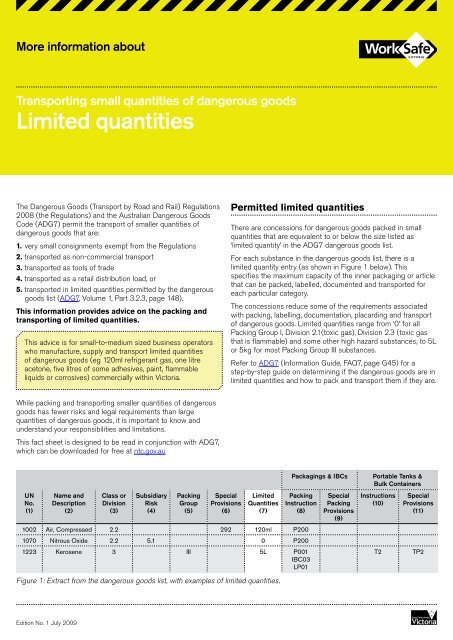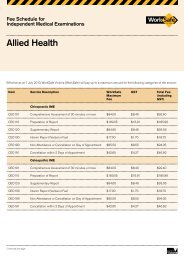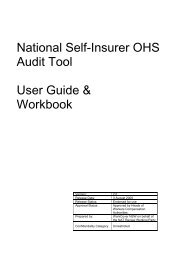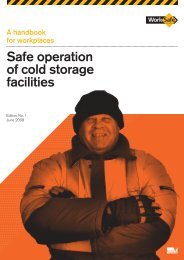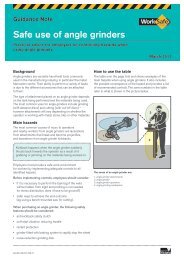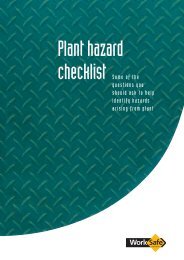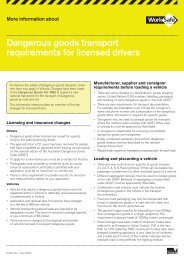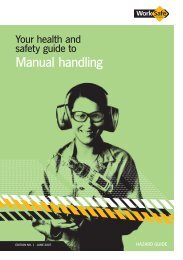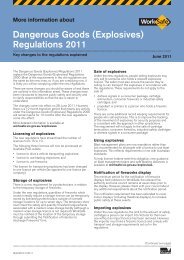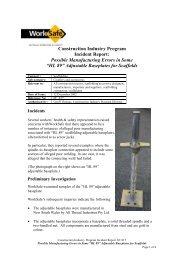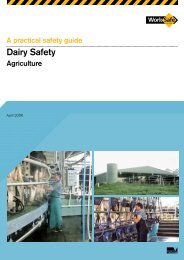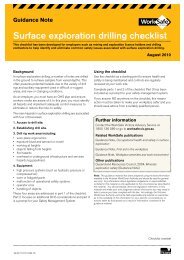limited quantities (PDF 181kb) - WorkSafe Victoria
limited quantities (PDF 181kb) - WorkSafe Victoria
limited quantities (PDF 181kb) - WorkSafe Victoria
Create successful ePaper yourself
Turn your PDF publications into a flip-book with our unique Google optimized e-Paper software.
More information aboutTransporting small <strong>quantities</strong> of dangerous goodsLimited <strong>quantities</strong>The Dangerous Goods (Transport by Road and Rail) Regulations2008 (the Regulations) and the Australian Dangerous GoodsCode (ADG7) permit the transport of smaller <strong>quantities</strong> ofdangerous goods that are:1. very small consignments exempt from the Regulations2. transported as non-commercial transport3. transported as tools of trade4. transported as a retail distribution load, or5. transported in <strong>limited</strong> <strong>quantities</strong> permitted by the dangerousgoods list (ADG7, Volume 1, Part 3.2.3, page 148).This information provides advice on the packing andtransporting of <strong>limited</strong> <strong>quantities</strong>.This advice is for small-to-medium sized business operatorswho manufacture, supply and transport <strong>limited</strong> <strong>quantities</strong>of dangerous goods (eg 120ml refrigerant gas, one litreacetone, five litres of some adhesives, paint, flammableliquids or corrosives) commercially within <strong>Victoria</strong>.Permitted <strong>limited</strong> <strong>quantities</strong>There are concessions for dangerous goods packed in small<strong>quantities</strong> that are equivalent to or below the size listed as‘<strong>limited</strong> quantity’ in the ADG7 dangerous goods list.For each substance in the dangerous goods list, there is a<strong>limited</strong> quantity entry (as shown in Figure 1 below). Thisspecifies the maximum capacity of the inner packaging or articlethat can be packed, labelled, documented and transported foreach particular category.The concessions reduce some of the requirements associatedwith packing, labelling, documentation, placarding and transportof dangerous goods. Limited <strong>quantities</strong> range from ‘0’ for allPacking Group I, Division 2.1(toxic gas), Division 2.3 (toxic gasthat is flammable) and some other high hazard substances, to 5Lor 5kg for most Packing Group III substances.Refer to ADG7 (Information Guide, FAQ7, page G45) for astep-by-step guide on determining if the dangerous goods are in<strong>limited</strong> <strong>quantities</strong> and how to pack and transport them if they are.While packing and transporting smaller <strong>quantities</strong> of dangerousgoods has fewer risks and legal requirements than large<strong>quantities</strong> of dangerous goods, it is important to know andunderstand your responsibilities and limitations.This fact sheet is designed to be read in conjunction with ADG7,which can be downloaded for free at ntc.gov.auUNNo.(1)Name andDescription(2)Class orDivision(3)SubsidiaryRisk(4)PackingGroup(5)SpecialProvisions(6)LimitedQuantities(7)Packagings & IBCsPackingInstruction(8)1002 Air, Compressed 2.2 292 120ml P2001070 Nitrous Oxide 2.2 5.1 0 P2001223 Kerosene 3 III 5L P001IBC03LP01Figure 1: Extract from the dangerous goods list, with examples of <strong>limited</strong> <strong>quantities</strong>.SpecialPackingProvisions(9)Portable Tanks &Bulk ContainersInstructions(10)T2SpecialProvisions(11)TP2Edition No. 1 July 2009
Transporting small <strong>quantities</strong>of dangerous goodsLimited <strong>quantities</strong>Packing groupsMany substances are allocated into one of three groupsdepending on their degree of danger. These groups indicate thedegree of protective packaging required during transportation iethe greater the danger, the greater protection required.Packing GroupIIIIIIDangerHighMediumLowThe Packing Group classification is commonly listed on thedangerous goods or material safety data sheet (MSDS) for theproduct, alongside its class/division.Licensing requirementsLicensing requirements depend on the amount of goodsbeing transported.Drivers and vehicles are not required to be licensed to transport<strong>limited</strong> <strong>quantities</strong> of dangerous goods. Licenses are required ifthe goods are in a receptacle with a capacity of more than 500litres, or more than 500 kilograms of goods are beingtransported in a single receptacle.Licenses are also required if <strong>limited</strong> <strong>quantities</strong> are transportedwith larger <strong>quantities</strong> of other dangerous goods above thelicensing threshold.<strong>WorkSafe</strong> <strong>Victoria</strong>Advisory Service222 Exhibition StreetMelbourne 3000Phone 03 9641 1444Toll-free 1800 136 089Email info@worksafe.vic.gov.auHead Office222 Exhibition StreetMelbourne 3000Phone 03 9641 1555Toll-free 1800 136 089Website worksafe.vic.gov.auLocal OfficesBallarat 03 5338 4444Bendigo 03 5443 8866Dandenong 03 8792 9000Geelong 03 5226 1200Melbourne(628 Bourke Street) 03 9941 0558Mildura 03 5021 4001Mulgrave 03 9565 9444Preston 03 9485 4555Shepparton 03 5831 8260Traralgon 03 5174 8900Wangaratta 03 5721 8588Warrnambool 03 5564 3200The information presented in this document is intended for general use only. It shouldnot be viewed as a definitive guide to the law and should be read in conjunction withthe amended Dangerous Goods Act 1985 and the Dangerous Goods (Transport byRoad or Rail) Regulations 2008.<strong>WorkSafe</strong> <strong>Victoria</strong> is a trading name of the <strong>Victoria</strong>n WorkCover Authority.2


